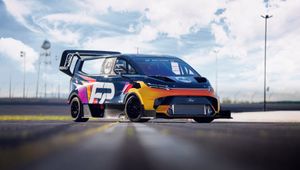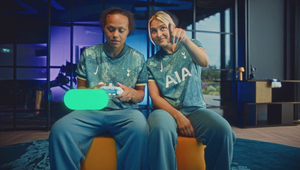
From Sets to Screens, What’s Next for Virtual Production?

In the ever-evolving landscape of film and video production, the industry is experiencing a transformative shift towards virtual production techniques.
Where traditionally we’ve been confined to physical sets and practical effects, filmmakers like us are now embracing cutting-edge technology to create immersive and visually stunning content.
The Mandalorian, the ground-breaking Star Wars series, became a trailblazer for virtual production with its use of “The Volume” – a massive LED screen surrounding the set. The technology not only immersed actors in realistic environments instead of enigmatic green screen, but also allowed for more efficient shooting schedules. As a result, virtual production is increasingly becoming a preferred choice for big-budget productions aiming to enhance both creative freedom and productivity.
At Chrome, we’ve come to appreciate not only the efficiency, but also the flexibility virtual production affords us. The ability to create and modify virtual environments in real time is game changer, especially when it comes to contending with UK weather and light – imagine shooting in ‘magic hour’ all day! And, we’ve also found other unexpected advantages to embracing this innovative production method.
Last year, Standard Chartered asked Chrome to showcase the financial institutions varied cultural identities, global presence, and key business areas – all whilst supporting their commitment to sustainability. Central to this shoot was the issue of how to show the breadth of Standard Chartered’s reach across industries around the world without having to physically circumnavigate the globe. Virtual production provided the ideal solution. From China to Europe, Singapore to the UAE, our sets were created using a mix of real-world cinematography with local teams and Unreal Engine computer-generated backgrounds. This technology allowed us to feature over 100 cast in 11 global locations across four continents, all from a single virtual production studio in London. This drastically reduced the carbon footprint that would have been generated had we travelled our core team to each of these locations in the physical world.
This wasn’t the first time we’d worked with Standard Chartered on a virtual production. Previously, on their ‘Walk with Us’ film, this innovative approach enabled us to bring viewers on a journey through a modern office, aeroplane hangar, vast wind turbine farm, modern city, futuristic warehouse, dense jungle and a train station – again from a central studio location.
Streamlining the production and capturing effects in-camera also allowed for the simplification of post production by reducing the need for VFX and CGI. These efficiencies allowed us to hit the client’s tight timeframe, with just two weeks from first cut to final delivery.
Efficiencies, however, are not the only goal served by virtual production. In some cases, it allows the impossible to become possible. When our clients at Ford were faced with quite possibly their biggest reveal in a decade – the first all-electric F-Series truck – they needed capability footage without the possibility of a leak to the public. Drive this top secret model, but don’t get caught – almost impossible.
To preserve the confidentiality around the F-150 Lightning’s high-profile release, while still providing premium, photo-real video and still assets, Chrome brought Ford a plan that contained the shoot to a completely controllable virtual production stage and used Unreal Engine to create three vastly different environments – a public charging station, a neighbourhood construction site and a campsite. As our VP Robert Chew pointed out; “With a traditional production, showing the full range of product features across different environments would have taken a multi-day road trip with a moving company. With this innovative global collaboration, it instead became 72 hours of footage captured in a technology-driven studio.”
Using clever camera movement and art direction, these virtual environments can offer clients and production teams even more flexibility than a practical set. As LED volume stages proliferate, virtual production will only become a stronger tool for the commercial production industry, offering a secure option for advertisers looking to film pre-release products under strict embargo.
Like any technological advancement, virtual production comes with its own set of challenges. The initial investment in equipment and training can be substantial, making it more accessible to major commercial or entertainment productions than to independent or low budget projects. Moreover, the learning curve for mastering real-time engines and LED volumes may deter some traditionalists.
At Chrome, however, we see the rise of virtual production as marking a paradigm shift in the film and video industry, with the future of virtual production in movies seeming (LED) bright. As technology continues to evolve, so does the potential for pushing creative boundaries. Real-time rendering, expansion into other genres, more accessible tools and technologies, and greater collaboration are some of the trends that will shape its future. Virtual production not only enhances the visual spectacle of films but also revolutionises the entire filmmaking process.
With more filmmakers embracing this innovative approach, the future of storytelling on screen has the potential to become limitless. Where do you think it’s headed? Would you shoot virtually or is the draw of on-location filmmaking still too strong?















